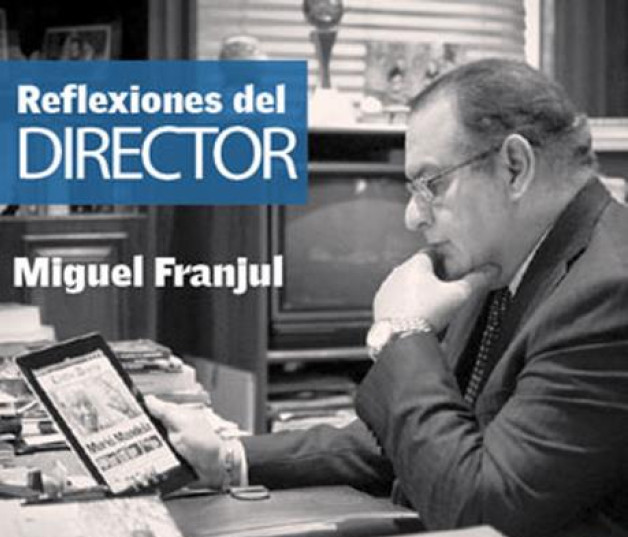Reflexiones del Director
Las “noticias lentas”

En esta era mediática, los diarios impresos tienen un amplio campo de oportunidades para dar nuevas dimensiones al periodismo profesional cambiando los tradicionales paradigmas en que descansaban sus coberturas informativas. De un modelo de dar sólo noticias del día hemos pasado a otro que ya se conoce como el del “día después”, que consiste en superar lo superficial y llegar a lo profundo de los acontecimientos por medio de tres premisas claves: explicación, contexto y análisis.
Los lectores se interesan más en los porqués de los hechos y en el seguimiento de estos, lo que obliga a los periodistas a no desmayar en la tarea de seguir excavando para llegar a la verdad que subyace en el fondo de los acontecimientos. Mientras los medios digitales y las redes sociales desfogan, minuto a minuto, hora a hora, los preliminares de los hechos que se consideran noticia, el papel de los medios impresos es el de dar contexto y análisis a los episodios, sin abandonar nunca la regla de oro de la verificación y la exactitud. No estamos ya para dar primero las noticias, sino para explicarlas, para descubrirlas en su verdadero contexto, porque lo más importante es la calidad de la información y sobre todo el punto de contacto o “enganche” con el interés de los lectores para que aterricen siempre en la realidad. En la dinámica de reinventarse, los medios impresos han logrado una buena simbiosis con los medios digitales y aprenden a diferenciar las formas y tipos de contenidos que se consumen en la multiplataforma, evitando la duplicidad. Es decir, combinando el sentido de lo instantáneo con el de la profundidad de las novedades que están más allá de las noticias de actualidad. Ahora se apuesta al paradigma de las “noticias lentas”; es decir, al de reunir el máximo de piezas dispersas, contextualizarlas y servirlas en su conjunto con todos los ángulos y matices que se pierden en el torrente rápido de las redes, y esto exige más investigación y precisión de datos. De ahí que, como dijera en unas de mis Reflexiones, es oportuno revalorizar algunos géneros, como el reportaje, la crónica, las narraciones y la investigación y, por supuesto, el análisis y las bases de datos, para alcanzar los objetivos que se plantean con estos nuevos paradigmas de la comunicación, a los que no debemos estar ajenos. Con la gran diversidad de informaciones que pueblan la esfera digital, los diarios impresos tienen aquí otra oportunidad para dar las repuestas que los lectores no encuentran en las redes y para identificar los nuevos “nichos” de lectores, según el interés que despiertan los contenidos referidos a temas poco tratados en el día a día, como los que aluden a derechos ciudadanos, salud, servicios públicos, medio ambiente, innovaciones tecnológicas y dramas humanos y sociales. En esas “noticias lentas” hay una mina de elementos que necesitan ser explotados con las mejores herramientas de la calidad del periodismo profesional, arrancando los secretos que se ocultan bajo la superficialidad del episodio puro y simple.
Traducción al inglés
The "slower news"
In this era of multimedia, printed newspapers have a wide field of opportunities to give new dimensions to professional journalism by changing the traditional paradigms on which their information coverage relied.
We've transfered from a model that only broadcasts the news of the day to another that is already known as the "day after", which consists of overcoming the superficial angles and reaching the depths of events through three key premises: explanation, context and analysis.
Readers are more interested in the causes of the events and their follow-up, which forces journalists not to give up in the task of continuing to dig to reach all the truths underlying the events.
While digital media and social networks are releasing, every minute and every hour, the preliminaries of the events that are considered as news events, the role of the printed media is to give context and analysis to the episodes, without ever daring to abandon the golden rule of verification and accuracy.
We're not here to spread the news first, but to explain them, to discover them in their true context, because the most important thing is the quality of the information and most importantly, "hooking" and forming a solid bond with the interests of the readers so that they always land in a reality field.
In the dynamics of reinventing themselves, the printed media has achieved a good symbiosis with the digital media and both have learnt to differentiate the kinds of content that are consumed within the multiplatforms, avoiding duplicity. That is, combining the sense of the promptness with the depth of the events, beyond the news.
Now we bet on the paradigm of the "slower news", that is, to gather the maximum amount of scattered pieces, contextualize them and serve them as a whole with all the angles and nuances that are lost within the fast-flowing networks, which demands more research and data precision.
That's why, as I said before, it's appropriate to revalue some genres, such as reporting, chronicles, narrations, research and, of course, analysis and databases, to achieve the objectives that are posed with these new paradigms of communication, to which we should not be oblivious.
With the great diversity of information that populates the digital sphere, the printed newspapers have here another opportunity to give answers that readers would not find in the Internet and to identify the new "niches" of those readers, according to the interest aroused by content or topics that are barely talked about in a daily basis, like those that allude the citizen rights, health, public services, environment, technological innovations and human or social dramas.
Within those "slower news" there is a mine of elements that need to be exploited with the highest-quality tools of professional journalism, tearing off all the secrets hidden under the superficiality of the pure and simple episodes.
- Translated from spanish by Randy Rodriguez.


